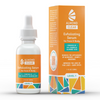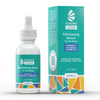Mandelic Acid for Ingrown Hairs
An ingrown occurs when a hair gets trapped beneath the surface of the skin and continues to grow. After the hair starts to grow beath the surface, it can take several growth patterns, either burrowing down into the skin, growing parallel to the skin, or coiling and curling as it grows. Ingrown hairs can be painful, and when they become infected with bacteria they can turn into swollen, red bumps or boils. Ingrowns occur anywhere on the body where hair follicles are present, but they’re most likely to crop up in the beard area or bikini line because the hairs found in these areas are often curly. People with naturally curly hair are more likely to experience ingrowns because their hair easily starts to coil away from the surface of the skin as it grows. So what can you do about stubborn ingrown hairs?
Ingrown Hair Self-Care Tips:
- If there is a red bump or boil present, then do NOT pick at the bump! A raised, red bump means that bacteria are present in the follicle, and picking at it will only spread the bacteria further into the surrounding tissue. Leave the hair alone until the boil has completely calmed down. In the meantime, start using a chemical exfoliant with antibacterial properties (more on that later).
- If you shave the area, then be sure to replace the razor once per week. Old, dull razors are a huge cause of ingrown hairs. For African American men, use a single blade razor.
- You can mechanically exfoliate (to exfoliate means to remove dead skin cells) the area by scrubbing gently with a clean washcloth or buffing sponge. This will help to remove any flakes of dead skin sitting on the surface, which is important because these flakes can trap hairs.
- It’s also incredibly important to include a chemical exfoliant in your skincare routine. Alpha and beta hydroxy acids are naturally-derived exfoliants that come from things like sugar cane, beets, milk, and almonds. Mandelic acid is derived from bitter almonds, and it’s an outstanding choice for battling ingrown hairs, razor bumps, and boils. Mandelic acid is strongly antibacterial and antifungal, so it attacks the infection that causes red, swollen bumps. It also gently removes dead skin cells and oil from the upper layers of the skin, allowing the hair to appear near the surface of the skin so that it can be extracted. Once the hair appears, it can be removed with a needle or tweezers. Be sure to sterilize the removal tool by washing it with soapy water and then placing it in boiling water for several minutes. Using a dirty tool increases the risk of spreading irritating bacteria into the hair follicle.
- To use mandelic acid for ingrowns: Apply a few drops of mandelic serum to the area in which ingrowns occur, then gently massage into the entire area and let dry thoroughly. Do not rinse. Start with every other day application and increase as tolerated to twice daily usage.
- Deep ingrown hairs that are very inflamed and painful may have to be removed by a doctor. Call your doctor if you have a painful ingrown that hasn’t responded to self-care treatments. A quick surgical procedure can remove deep ingrowns.








